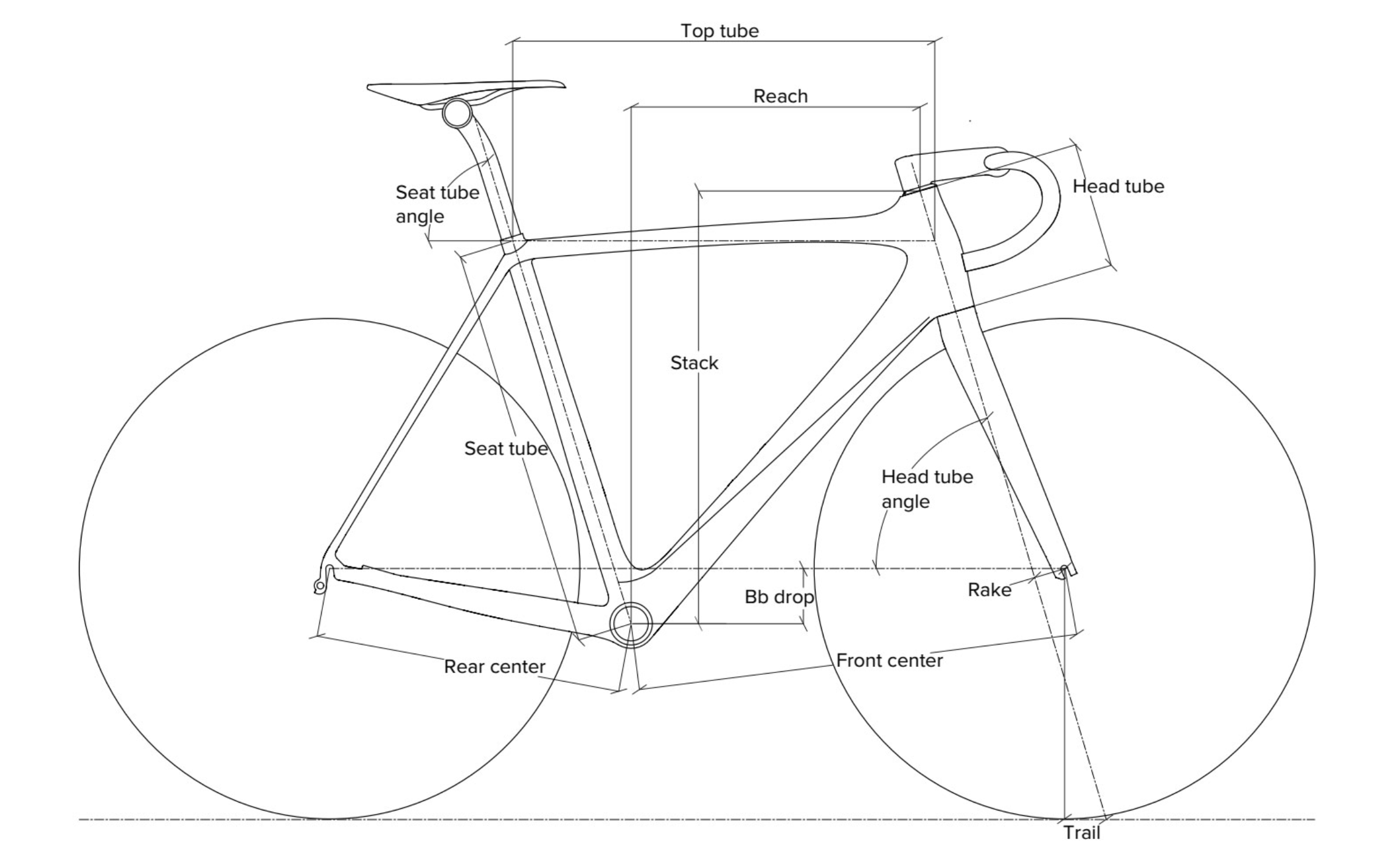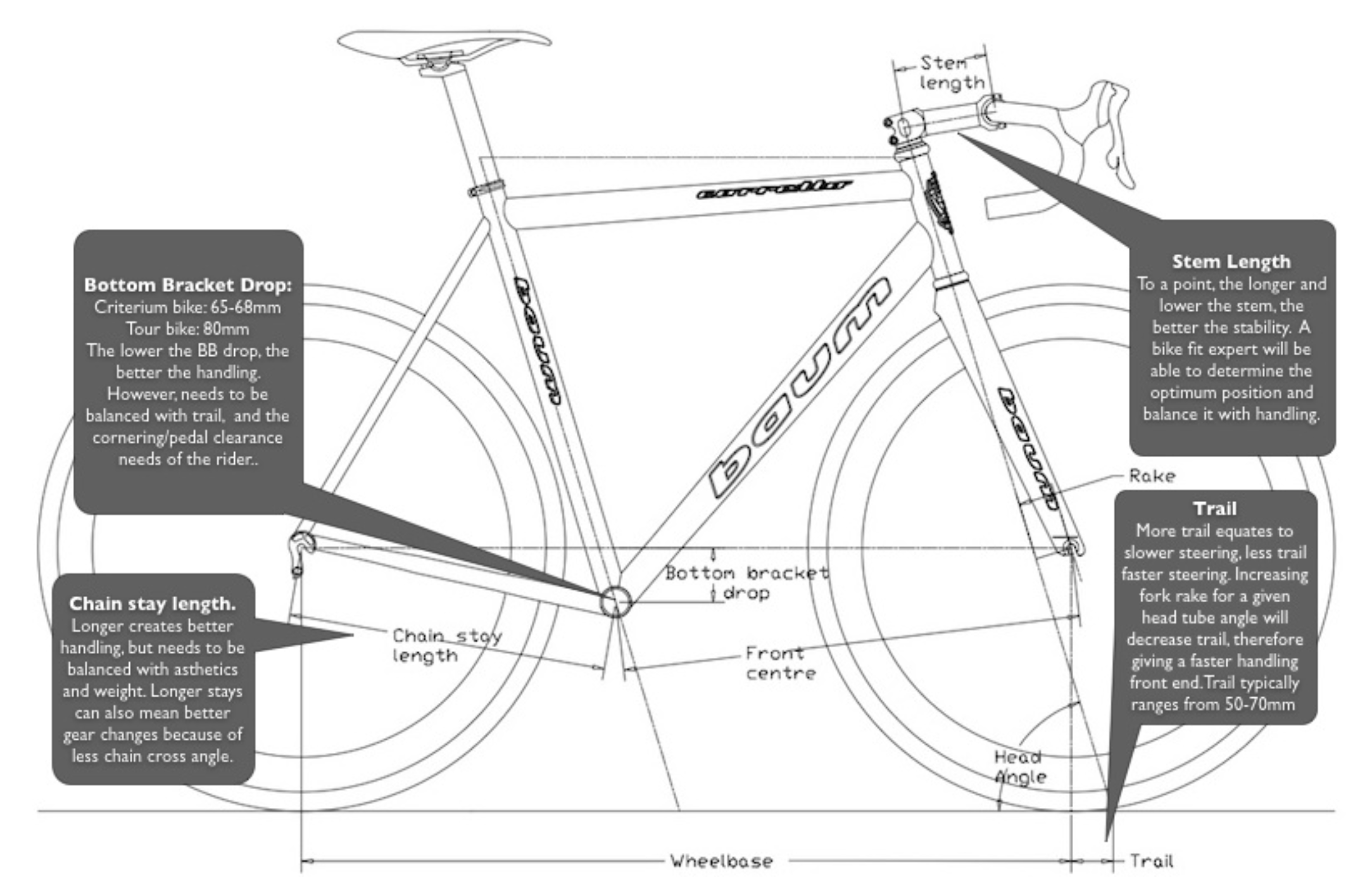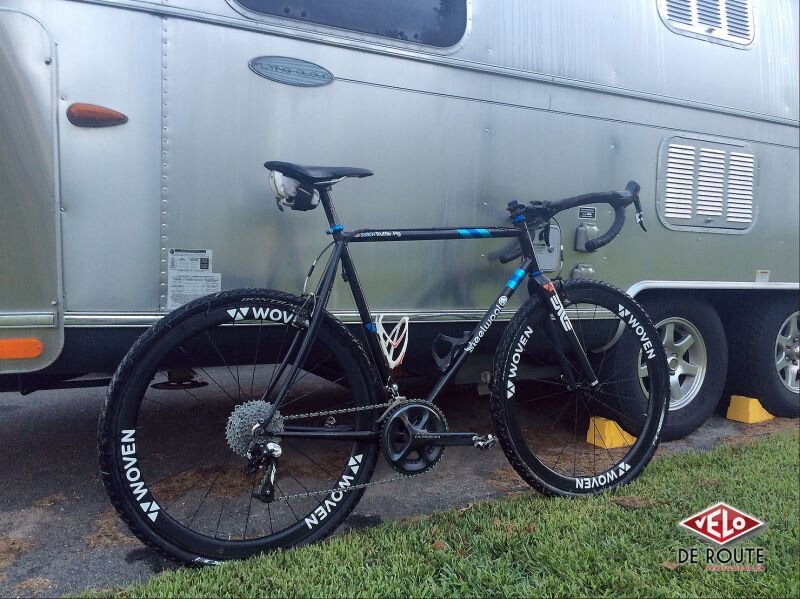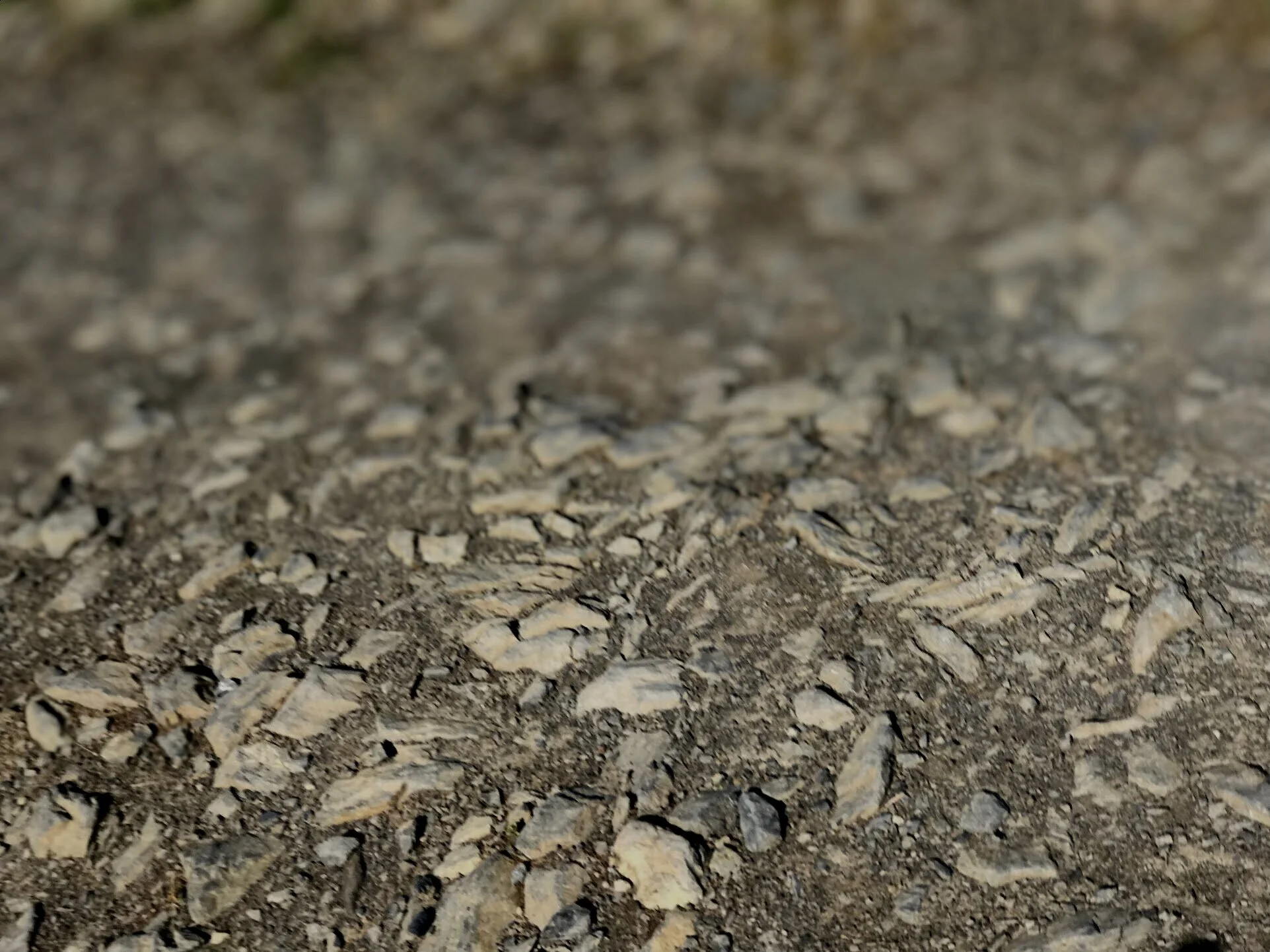MATTER of FACT: How to Understand Gravel Bike Geometry
In MATTER OF FACT: Gravel Bike Key Questions and Materials, I walk through key questions a prospective buyer or builder should ask when evaluating gravel riding needs. I also took a look at the pros and cons of the typical frame materials available.
In this article I get into three aspects of frame geometry: trail, wheelbase, and ride height. These aspects are worth spending some time getting comfortable, or at least acquainted with, if you want to make sure you land on a bike that meets your expectations.
You can find the rest of my writing on the subject of gravel bikes here.
It seems wise to first clarify what 'geometry' is in relation to bikes. In this context, we're talking about the critical angles between frame tubes that are used to accomplish two things:
provide the right fit of rider to bike
provide the desired ride characteristics from the bike under that rider.
My analysis of geometry charts from different brands' gravel bikes reveals that some lean toward a mtb crowd, and others toward the cyclocross end of the spectrum in terms of fit. The former is more upright, and the angles are slacker. This is to provide more stability at speed on loose surfaces, which some riders will want.
Stability at speed comes down to a few key geometry factors: fork rake and fork trail, wheelbase, front-centre, and bottom bracket height. More on these below.
Design Constraints
Bike companies that produce stock geometry bikes tend to make a range of sizes for each of their models. Meanwhile, custom builders will build bikes in dimensions tailored to their clients. Both parties are constrained by a few aspects of the overall system:
1) Forks are mass produced in a small variety of lengths for a given wheel size, and with a small range of rakes (more on rake below). Custom forks in carbon are very rare.
2) Each bike is constrained by bottom bracket and crank standards, which determine how wide the bottom-bracket shell can be (or narrow), which affects tire clearance. If you want to use a road crank on a cyclocross frame (as is standard), the arms will hit the chainstays if you place them too wide in an effort to fit a 50mm tire.
3) Each bike is constrained by the rear hub spacing dimensions available, which influence the angle of the chainstays into the bottom-bracket shell, and thus crank clearance.
4) Front derailleur clearance to the back tire affects chainstay lengths. The introduction of single-ring drivetrains has enticed many builders to ditch the front derailleur, and use shorter chainstays.
5) Drivetrain function - simply, if chainstays get too short, drivetrains don't work well. Cervelo has pushed about as far as typical drivetrains can handle, 415mm chainstays. 420mm tends to be the shortest stay length we see on gravel bikes these days.
Front-end Geometry: Forks, Rake and Trail
Most of the constraints discussed above don't manifest as issues for the average rider, because they tend to be dealt with in similar ways across the board, with the exception of fork geometry. This is where builders who have the ability to either make or source forks with different rakes for each of their sizes will have the edge in terms of handling. However, if we look at ENVE, for example, who produce perhaps the best carbon forks on the market, we'll see that each fork comes in one rake alone. In the case of their gravel fork, rake is 47mm.
Many custom frame builders spec ENVE forks because they are so good, but they have to work around the one rake offered for each format (road, cyclocross, gravel, mtb). Wound Up, in contrast, offers two rakes for their gravel fork, and three for their 'commuter' fork (which is good for road bikes with large tires). However, Wound Up has far less market penetration than ENVE, and their bonded, modular design lends a more old-school look to their forks than a lot of riders are interested in, particularly when matched with oversized head-tubes. From a handling perspective, however, being able to spec the best of two rakes has its benefits, andI can attest that their forks ride very well.
If you look at geometry charts across the industry, you'll see that some companies use the same fork rake for each of their sizes in a given model. This is because it's too costly to source more than one fork for use across sizes. Some companies, if they are doing enough volume, will use two rakes, which will improve things. However, in general, the bikes are being designed so that the most common sizes, 55-58cm have the 'ideal' geometry, while the extremes - x-small and x-large - wind up with less than ideal geometry.
For example, the smallest size offered in a given model will use a very raked out head angle (slack, perhaps 69 degrees), but the same fork rake as a bike with a 73 -degree head angle in a common size. The result is two very different trail values, and thus two bikes that ride rather differently. Spoiler, the small bike won't ride as well as the bigger bike. This is why small riders are often best served going with bikes made by custom builders who can build them custom forks in the rakes required. Yes, they are heavier, but handling should trump weight.
A proposed solution I submit to the industry, would be a fork that uses a thru-axle design that accepts eccentric insert to offset the axle front to back, thus adjusting rake. We're only talking about a difference of millimetres. I hope we see one of the leading carbon fork brands come out with such a design soon. (UPDATE: Two manufacturers either read this when I originally posted it in 2017, or came to the same conclusion independently: Columbus and Cervelo)
In practical terms, what sort of trail is good for gravel? Well, it depends...sorry. What does it depend on? Tire diameter and volume, primarily. Secondarily, body positioning. I don't think this is the time to get deep into trail, I'll try to keep my advice simple here.
The 'right' amount of trail you're looking for in a bike has a lot to do with how fast you'll ride it, and what the surfaces will be like that you'll ride on. Really soft surfaces are best ridden on a bike with low trail, which means the front wheel doesn't tend to want to flop over when leaned. This is key when turning on loose surfaces, because you want the wheel to be able to slide a bit without actually turning under. Think motorcycle-style counter-steering; that's what you want the bike to want to do.
If you will carry a load up front - perhaps in a handlebar bag - you'll want low trail. Read Jan Heine's reams of writing on randonnee bikes if you are keen to learn more about loaded off-road riding.
So, you want me to throw out a trail value that's good, right? Ok.
My custom Steelwool Secteur 18 is extremely stable on loose, fast descents with tires from 28mm up to 35mm. It's probably best with 32mm tires. Here are the bike's specs:
Head Angle 72.5
Seat Angle 73
Chainstay length 422mm
Bottom Bracket drop 80mm
Seat Tube (Centre to top) 57cm
Top Tube (Centre to centre) 58.7cm
Front Centre 624mm
Head Tube length 166mm
Fork (Axle to crown) 376mm
Rake 49mm
Trail 58mm
With 32mm tires, its trail is 58mm. This is on the low end of the trail spectrum, and I find it works exceptionally well. With 28mm tires, the trail drops by 1mm. For the sake of comparison, my Steelwool cyclocross bike also handles very well on gravel, and it has a steeper head angle (73 degrees), a higher BB (70mm drop), and a slightly less raked fork (47mm). With a 33mm tire, the trail is 57mm - neat, eh? With a 35mm tire (like the Compass Bon Jon I use a lot), the trail becomes 58mm. Look at that, exactly like my Secteur with 32s! I'll go as big as 38mm on this bike, which brings trail to 59mm.
This is my current all-rounder setup. Brodie Romax carbon, with geo very close to the aluminum Romax, except with more fork rake: 50mm. It’s pictured in adventure mode, with 650b x 48mm Rene Herse tires, in Rome.
UPDATE: The bikes I’ve been riding more recently (2018, 2019) run longer trail than my older bikes, and I enjoy them equally! Trail is complicated, and the numbers don’t tell the whole story. My aluminum Brodie Romax cyclocross are at 64mm trail with 700c x 35mm Bon Jon tires, which feels great. With 650b x 48mm tires, trail drops to 62mm. My custom titanium T-Lab gravel bike has a slacker headtube and more rake on the fork, but it’s trail numbers are identical. These two bikes don’t handle the same! Both are great, however. The T-Lab has the edge for sure when it comes to dealing with slippery off-camber terrain, which the numbers don’t reflect at all.
UPDATE: I expand on these dynamics in detail in the 2022 piece, MATTER: Columbus Futura Cross, Adjustable Rake, and Steering Stability
Trail between 55 and 64mm should get you where you want to be.
Wheelbase
Wheelbase sort of takes care of itself, in most cases. A short wheelbase bike is sort of like short skis. It won't track as well on loose surfaces as a longer wheelbase bike. This is why downhill mountain bikes have gotten progressively longer over the years. Longer front ends and longer forks make the bikes track straighter and more stably. Note that their handlebars have also gotten much wider to compensate for their raked out geometries.
On a 'gravel bike,' using a straight seat-tube (still the standard, mainly because of front shifting requirements) means chainstays can only get so short while maintaining tire clearance to the seat-tube and front derailleur. So a designer has to determine what the maximum tire size should be, then build the chainstays long enough to achieve the tire clearance desired to the seat-tube. For a cyclocross bike, this tends to be about 425mm. The Specialized Crux, for example, uses this length for every size. As with touring bikes, where stability at speed is a priority, long chainstays (430mm +) can contribute to a long(ish) overall wheelbase, which make for stability.
But long chainstays are not the only way to achieve increased stability at speed, as we've known for some time. Think back to Gary Fisher's Genesis Geometry, which one might say took cues from BMX-style mountain bikes like the Spooky Metalhead and applied them to cross-country mountain bikes. Mountain bikes went from using 130mm stems, just like road bikes, down to 50mm stems over about 15 years. With the OPEN U.P. and 3T Exporo, we see the introduction of shorter rear ends, slightly longer front ends finding their way into gravel in the guise of what I’d call ‘fat tire road’ or ‘all-road’ sub-categories of either road or gravel; take your pick.
While wheelbase might stay the same, the feel of bikes build around these different approaches will vary considerably, especially out of the saddle. Essentially, the head-tube swings back and forth when we turn the bike, in relation to the front wheel's contact with the road/trail. The longer the stem, the longer the further the head-tube swings for a given amount of angling of the front wheel. With forward momentum pushing the head-tube forward through space, the further it swings from centre, the more the trailing frame wants to push it, again, in relation to the front tire tracking on the ground. If you picture what happens when a rider crashes on a turn in cyclocross, for example, most of the time the front tire slides, then actually rolls backwards as the head-tube pushes the wheel beyond the angle it can grip the ground. I'm sorry if I'm not explaining this as clearly as one might.... On my understanding of these dynamics, I think a longer-than-typical front end on a gravel bike is more desirable than the opposite. We're talking about maintaining the same weight over the front wheel, but achieving this in a different way than typical.
UPDATE: I applied this rationale to the geometry spec of my custom T-Lab gravel bike, which is toward the dropbar MTB end of the spectrum. In short, it worked out exactly as I’d hoped; the bike handles like a boss! Look for another post on details.
I don’t look closely at wheelbase on geometry charts, and you probably don’t need to either.
Ride Height
A key consideration for gravel bikes, be they dedicated or adapted cyclocross bikes, is the ride height. Ride height is another way of saying 'centre of gravity.' Unfortunately, this aspect of bike design is left out of geometry conversations far too often, because it really matters to a rider’s confidence across all speeds.
On a cyclocross bike, a relatively high centre of gravity might be desirable for a couple reasons:
it enables easier bunny-hopping of barriers than a low centre of gravity;
it means pedals have more clearance to the ground for pedaling through turns and across off-camber sections.
But how is a high centre of gravity achieved? There are two ways, aside from changing wheel diameter:
Bottom bracket height. The higher it is, the easier it is to pull the front wheel off the ground, pivoting around the rear axle.
Crank length. Long cranks require a low saddle, short cranks allow for a higher saddle.
Crank length impacts centre of gravity while in the saddle, but not while standing. Descents are ridden standing, so long cranks are not a good way to get the weight low.
With 29 x 2.0 tires, this bike was tall. I typically ran a lower stem, but when this photo was taken I was testing the Stafast suspension unit. I plan to try this bike with 650b wheels in 2020.
For a bike that will never see barrier hops and aggressive cyclocross racing, a high bottom bracket will serve no useful purpose on a gravel bike. Instead, it will make descending unstable. Rather than feeling like you sit 'in' the bike, you'll feel like you sit 'on' it. In my eyes, the only way a high-bottom bracket cyclocross bike is good for gravel is if it has disc brakes and allows the rider to use 650b wheels (see this resource for wheel dimensions). I created the table below to capture the range of bottom bracket heights between bikes I ride on gravel, compared up against a typical 'euro-style' cyclocross bike, the Ridley X-Night.
A low bottom bracket will feel stable, all other factors consistent. In addition, if/when riding on slow, rocky trails, the rider's foot will be closer to the ground for dabs. How is this achieved?
If the wheel diameter is fixed, the 'drop' of the bottom bracket below the horizontal line dissecting the wheel axles determines the bottom bracket height. A 'low' figure for a 700c bike is 80mm (see the Secteur 18 above), which used to be common for most road race bikes. A 'high' figure would be 65mm (see the Ridley X-Night above). I've seen bikes with drop as low as 90mm, for touring, but they are difficult to pedal around turns, and are considered outliers.
Bottom bracket drop is normally a fixed element, unless we are talking about a bike with an eccentric bottom bracket, which allows the crank axle to be rotated around an eccentric path, forward, back, up, down. A typical bike won't have that, but it is worth considering if you are having a custom bike build you want to adjust drop on for different wheels...). If it's a cyclocross bike, the bottom bracket drop is set with a particular outer tire diameter in mind. If it's a race bike that the designers expect to be raced as its primary function, the assumption will be that 33mm tires will be used (I used 32mm above, from the linked table). With that size tire, one can use a high-ish bottom bracket drop and keep the centre of gravity reasonable for all-round performance.
I raced this bike a few times with these Bontrager 700c x 38mm tires, notably, at Vermont Overland. They measured closer to 40mm, and felt good at speed, as this bike has 70mm bottom bracket drop. RIm brakes made it impossible to run 650bs.
But what if the rider doesn't race at all or much, and instead wants to use the bike with 38mm tires? Well, the bottom bracket drop won't change, but its height in relation to the ground will. The rationale for riding 38mm tires is likely that the rider will face rough terrain, where a low bottom bracket is likely desired for stability, especially at speed. Oops. Instead, the bike will ride as if on stilts at slow speeds, and despite the fat tires, won't perform as well on loose surfaces as a lower bike. However, to be fair, the added inertia of larger tires increases stability at higher speeds, so in many cases the bike will feel fine.
If it's a disc bike we're talking about, one could avoid the problem of excessive ride height by using 650b wheels with 38mm or larger tires and end up keeping the bottom bracket at about the same height. The table above shows that the geometry of a 'euro style' cyclocross bike like the Ridley X-Night is good for smoothish gravel riding when using 700 x 32 or 33 mm tires. So if one is going to get away with using tires 33mm or smaller for road and gravel riding, a bike like this will work well. However, if one wants to take on rougher terrain, 33mm tires are often not big enough. Bumping up to 770c x 38mm tires (some CX bikes fit larger, up to 42mm), the bottom bracket height becomes too elevated for high-speed stability on loose surfaces.
The better approach is to either choose a bike with a lower bottom bracket for use with 700c wheels, or, adapt a high bottom bracket bike like the Ridley with 650b wheels. For my disc bikes, my rule of thumb is that when I want to run tires larger than 700c x 38mm I swap to 650bx 42mm or 48mm. The exception to my rule would be applied if I was going to ride far and long on rough terrain that didn’t require much bike handling; think Dirty Kanza. For that sort of thing I’d want a ‘juggernaut’ tire set-up, like a Rene Herse Snoqualmie Pass in 44mm, or Antelope Hill in 55mm.
Now what?
Where do we land? In terms of format - this isn't a geometry thing - disc brakes lend the most versatility to a given bike, in allowing the rider to relatively easily adapt the bike to the terrain to be ridden. This applies to wheel diameter and rim width. That is, if one wants to run a range of tire volumes on a given platform, it's ideal to match rim widths to tire widths. This will become more common as the years pass, but to future-proof, discs will allow for maximal flexibility, and reduce brake adjustments when swapping between wheels. You’ll be hard-pressed to find a new cyclocross or gravel bike with rim brakes in 2019.
I personally have had excellent results with 'road geometry' on loose roads, but with larger tires (700c diameter). What I always want for that sort of terrain is a bottom bracket drop of 70mm - 80mm. A little less is ok, but not much less. As you go up, high speed stability suffers. This is why many 'euro' cyclocross bikes are scary on fast dirt/gravel descents like those of D2R2. I recommend you do not buy such a bike for gravel riding, unless you plan to either use 650b wheels or stick to 33mm or smaller tires.
The chart above reflects that fact that a low ride height provides less pedal clearance for rocks and roots on trails. However, I don't personally get hung up on this aspect. At 312mm (yes, this is more than a foot!) off the ground, my Niner is so high my tip-toe reaches the ground when I'm in the saddle, and I would take a lower ride height over more pedal clearance on this bike any day. For reference, my Brodie cyclocross bikes with 70mm drop are TOO LOW for trails when run with 650b x 42mm tires. Pedal strikes are common. However, those same frames with 650b x 48mm tires are excellent on trails AND dirt roads.
A bottom bracket height between 260 and 280mm with the volume of tire you actually want to ride on gravel will put you where you want to be. Make sure you always factor the biggest tire you'll want to use when choosing a frame, and consider using 650b wheels to eke out even more tire volume if you need it.
I must admit that while I have a good sense of the geometry I want in a 700c wheeled bike for gravel, the opportunity to design a 650b/700c platform would present interesting challenges. I would run a front derailleur for certain, which would preclude using much shorter than typical chainstays (though the new direct-mounts for front derailleurs could help). The rear end of the bike could remain typical, albeit with tire clearance for 50mm tires achieved by using asymmetrical chainstays like the Open UP or 3T Exploro. I would prefer either thin seat-stays for passive suspension, or perhaps a Moots YBB-style in-line shock on the seat-stay yoke. I would tend toward a top-tube with a flattened profile for a bit of additional resilience over a round tube. The main quandary would be whether to run a regular top tube length, or go longer and specify a shorter stem. Going longer would increase the wheelbase, lending greater stability, while handling would become a little more 'direct' with a shorter stem. How would it feel?
UPDATE 2022: I’ve had opportunity to explore these questions! I worked with T-Lab bikes in Montreal to design and build a titanium frame based on the parameters I discuss above. The experiment has gone great so far; and as of September, 2022, the bike has almost 18,000km on it, including 20 days riding in Spain and France. In a nutshell, my geometry worked exactly as desired, and the bike has performed exceptionally well in the most demanding situations I’d wish to subject a drop-bar bike to. I’ve had opportunity to test a variety of theories on the frame, and validate my theories with respect to front-end geometry and wheel/tire dynamics. You can dig into lots of detail here: Gravel Bikes Collection. You can also read about the most demanding day I’ve spend on the bike, a dirt road version of 6-Gaps in Vermont. This piece covers the details relevant to riding mountains. Somewhat amazingly, I used the same bike with 700c wheels and a larger chainring to ride mountains in Europe in July/August 2022, and it worked really well. The next iteration of T-Lab’s X3 is on the horizon, so stay tuned to learn how we’re improving on an already fantastic bike.











